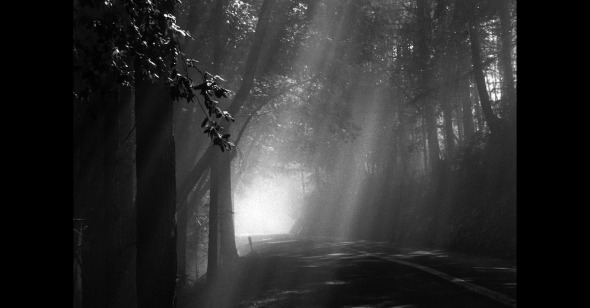The Natural
By Yuka Murakami
Sanctuary Station
Brigid McCaffrey, U.S.
Unstable Rocks
Ewa Rosińska, Germany/Portugal
At this year’s First Look, the pairing of Brigid McCaffrey’s debut feature Sanctuary Station and Ewa Rosińska’s short Unstable Rocks reflects the longstanding relationship between analog filmmaking and environmental concern. Both films, shot on 16mm, were made over several years while following artists and eco-activists living on the fringes—McCaffrey in remote areas of northwestern California, and Rosińska in various regions of Portugal. Careful compositions and a clear demonstration of the 16mm apparatus (in-camera editing, double exposure, single-frame shooting, etc.) are emphasized in lieu of consistent through lines or conventionally imparted information. While there is an interconnected, global effort to contend with the current climate crisis, these films reiterate the fragile power of individual attempts to mitigate our ecological footprint and admit the absence of a tangible path forward. The often solitary experience of analog filmmaking, as exemplified by the landscape films of James Benning, Babette Mangolte, and Peter Hutton, necessitates a free-form style that takes into account the scope and contingencies of nature itself.
A central figure in Sanctuary Station is the ex-nun and Beat poet Mary Norbert Körte (1934-2022), whom McCaffrey records in close quarters in the cabin Körte built for herself deep in the Redwood Forest. Over asynchronous footage she reads some of her poems, which have a meandering, spartan quality suggestive of a long period of isolation, “She heats her house with wood cooked stove oven all winter long, into freezing river frozen trees broken with frozen snow. She has been asked, interrogated, the hound of heaven truth...” Körte, who must have been in her mid-eighties when she was filmed, appears present and undemanding, paralleling with the young anti-deforestation group in Mendocino that McCaffrey also documents. Various moments of their gatherings, everyday routines, and leisure are filmed with detachment, and these encounters are juxtaposed with Körte’s domesticity, drawing cycles of life, which are further elucidated by the end of Sanctuary Station, when the shots of the forest, trees, and fields transition to the Pacific Coast. The careful attention McCaffrey devotes to the youth and their synergistic movements across distinct activities (i.e., how an exercise in acrobatics can apply to climbing tall trees for preservation efforts) asserts one’s adaptability to the natural order.
The piecemeal portrait of the Portuguese landscape in the 25-minute Unstable Rocks features no dialogue and is structured around a slow progression of perceptible ecological ruin. Images that alternate between decay and warmth are edited together with an insistence that such extremes are a daily fact; cuts from a shot of an airplane to a bird carcass, or a dead snake to a winding road, all of which lead to a scene of an evening night out with Rosińka’s friends, mirrors the multiple variations of loss and relief we face on any given day. Brief moments of Catholic prayer and ritual are interspersed with long takes where the camera is aimed at the sky, following a bird’s flight path. The film ultimately finds resolve in the titular stones, as rocks symbolize a sense of permanence and history across many cultures. In its spareness and without bearing any explicit markers of Portugal, Unstable Rocks relies on abstraction to communicate a universal cause.
With the ongoing deregulation of the EPA and an already weakened state of international climate defense movements, one can feel an inherent desperation while viewing these films. But experimental documentaries, in their aesthetics of decline and fragmented temporalities, can offer a bleak albeit beautiful pause—a standstill at a great distance that refuses to give in to despair when faced with the realities of complete environmental collapse.
These films screened together for MoMI's First Look 2025 festival on Friday, March 14.
